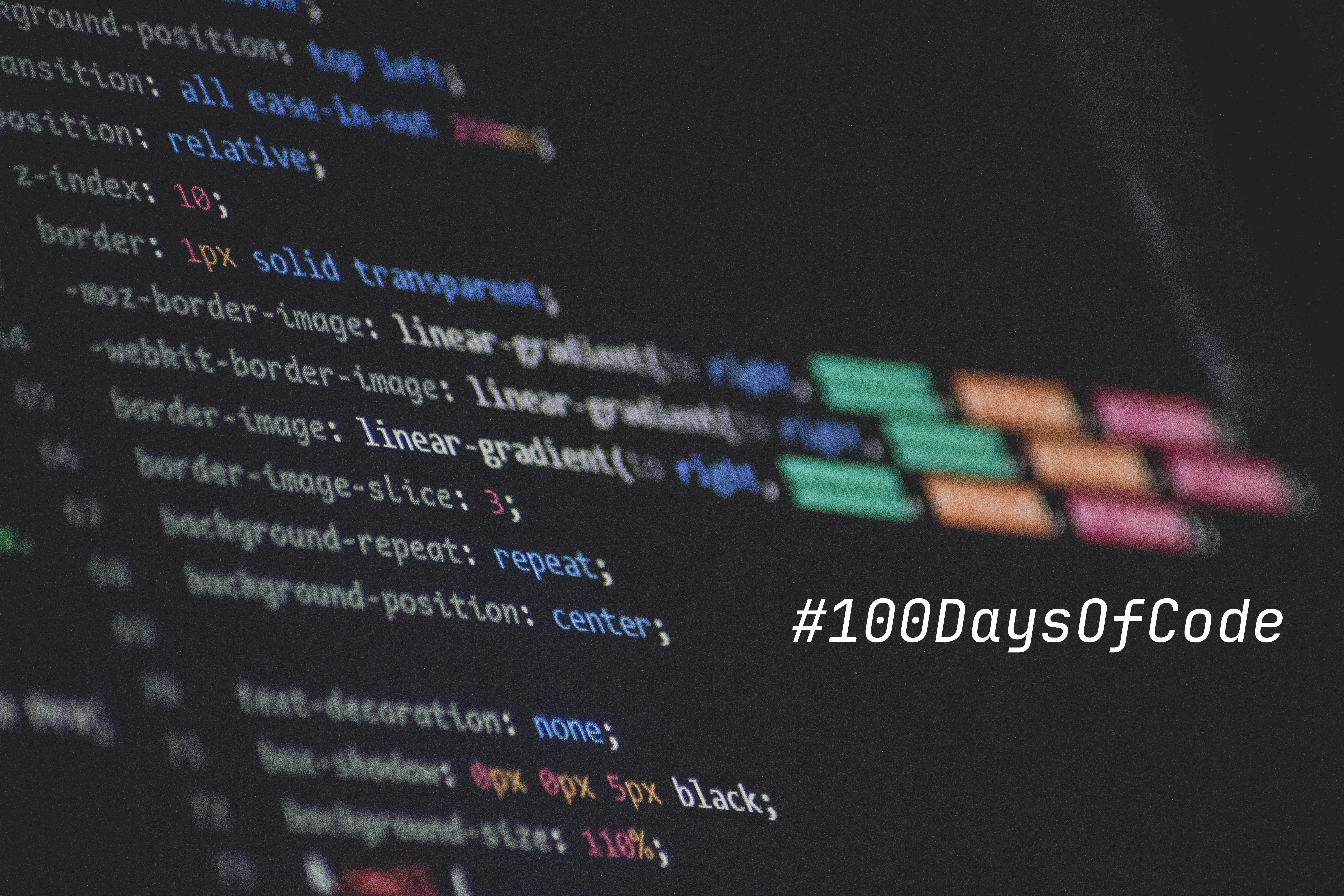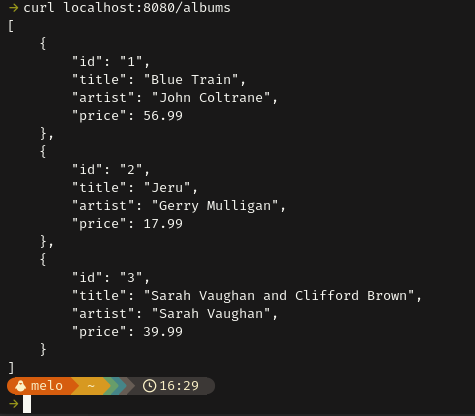Reaching day 50 - Coming back again

Oh well… Hi there!
A bit of a time off, right? Last time I wrote a post entry for my blog was mid-November, but I have quite some stuff ongoing on my personal life, so had to figure out how to focus and enjoy coding again, let’s get to it, then!.
Day 44 - 08/12/2024 - Starting somewhere - Let’s do a tutorial about RESTful APIs
Might sound a bit easy-going, but since I’ve been struggling quite a bit with focus and trying to get my mind to code, I believe that a copy-paste kind of tutorial could be a way to come back, as of the time of writing, I might be correct, I wanted to do more once I finished!.
In summary, I followed this tutorial that covers how to use Golang and Gin framework in a simple way to operate GET and POST operations, my next steps on this might be even making this API bigger, since by default no information is stored persistently, a CSV file or a simple SQL database collection might be useful for this.

Day 45 - 11/12/2024
Well, I took the lead for creating APIs and this time I tried out to use an already existent API, like the openweather one, and sort of got it to work, but ended up getting repeated 401 Status codes, so I ended up a bit stucked, my goal rn is just to retrieve the entire JSON for the Get request I made, here is the code:
package main
import (
"fmt"
"io" // Import the internal package
"myweatherapi/internal"
"net/http"
)
func main() {
fmt.Println("Hi")
// Create a new HTTP client
client := &http.Client{}
// GetAPIKey - internal package
apiKey := internal.GetAPIKey()
url := fmt.Sprintf("https://api.openweathermap.org/data/3.0/onecall?lat=33.44&lon=-94.04&appid=%s&units=metric", apiKey)
resp, err := client.Get(url)
if err != nil {
fmt.Println("Error in GET request:", err)
return
}
defer resp.Body.Close() // Ensure response body is closed
//fmt.Println("Request successful!")
if resp.StatusCode != 200 {
fmt.Printf("Weather API not available - Error Code: %v", resp.StatusCode)
body, _ := io.ReadAll(resp.Body) //ignoring error and checking content of response
fmt.Println("Response", string(body))
}
}
After that mentioned error, and since I already have a simple API, I have gotten to a conclusion that may be I can create my own API endpoint and then call it from my own endpoint, that would involve the whole two ends of the spectrum, since I could get as deep as I want, storing data within a database etc.
Another option would be to follow this tutorial applying the same concepts I followed for this first part of my API client.
Day 46 - 12/12/2024
This time I tried to rotate onto a different approach I briefly disclaimed yesterday, what if I use my own simple API to check my code? It should be agnostic enough of the API itself so I could use any and still get a response, right?
Well, that’s true, and after some trial and error, i got it working! Sidenote that I needed to specify http:// prior to the rest of the url for it to work correctly

Ideally from here I should be able to filter which JSON tags I want to keep & show accordingly.
So, getting back to the Weather API, lets try something different.
Day 47 - 15/12/2024
I did it! I have a very simple API client that worked both with my local API and the Weather API one. I still don’t know why my attempt with Openweather went wrong, but it should be fine to modify this script briefly if I got that one working eventually.
So here’s the final curated code!
package main
import (
"encoding/json"
"fmt"
"io"
"myweatherapi/internal" // Import the internal package
"net/http"
)
type Weatherdata struct {
Location struct {
City string `json:"name"`
} `json:"location"`
/*
Expected response
{"location":{"name":"Barcelona","region":"Catalonia","country":"Spain","lat":41.3833,"lon":2.1833,"tz_id":"Europe/Madrid","localtime_epoch":1734278478,"localtime":"2024-12-15 17:01"}
*/
Current struct {
TempC float64 `json:"temp_c"`
Condition struct {
Text string `json:"text"`
} `json:"condition"`
} `json:"current"`
/*
Expected response
"current":{"last_updated_epoch":1734278400,"last_updated":"2024-12-15 17:00","temp_c":13.3,"temp_f":55.9,"is_day":1,"condition":{"text":"Partly cloudy","icon":"//cdn.weatherapi.com/weather/64x64/day/116.png","code":1003}
*/
}
func checkError(err error) {
if err != nil {
panic(err)
}
}
func main() {
// Create a new HTTP client
client := &http.Client{}
// GetAPIKey - internal package's only function
apiKey := internal.GetAPIKey()
// Weatherapi
url := fmt.Sprintf("https://api.weatherapi.com/v1/current.json?key=%s&q=Barcelona&aqi=no", apiKey)
resp, err := client.Get(url)
if err != nil {
fmt.Println("Error in GET request:", err)
return
}
defer resp.Body.Close() // Ensure response body is closed
if resp.StatusCode != 200 {
fmt.Printf("Weather API not available - Error Code: %v", resp.StatusCode)
body, _ := io.ReadAll(resp.Body) //ignoring error and checking content of response
fmt.Println("Response", string(body))
}
body, err := io.ReadAll(resp.Body)
checkError(err)
var tiempo Weatherdata
err = json.Unmarshal(body, &tiempo)
checkError(err)
city, weather, sky := tiempo.Location, tiempo.Current.TempC, tiempo.Current.Condition
fmt.Printf("%v %v°C %v", city.City, weather, sky.Text)
}
So…what’s next? I recall that I did stop my progress with Let’s Go book by the point where it covers Database connections and all that, so my idea for the next iteration of this particular project is to transform my local API into a REST API using MongoDB.
Day 48 - 22/12/2024
Actually… May be I started too far from reality, it is true that working directly with a NoSQL database would be easier to extrapolate values from the current exercise I did following Golang’s site tutorial, though I also have some experience with SQL, so why not take chance to do a bit of a journey?
First, I will be learning about connecting to SQL databases, for that, I will be using a Debian 12 VM that will have eventually installed both MySQL and MongoDB servers, using a bridge network interface should be fine to get this result, so far I got a successful ping connectivity. This also gave a bit of a refresh about installing mysql server and how to create and manage databases. Source 1 Some Documentation I used to confirm my recent applied changes
For the step above I also have some guidance over Let’s Go book by Alex Edwards and the already disclaimed Golang community server at Discord.
Secondly, I will be using JSON data within MySQL, giving more a clear approach to using both REST API responses in JSON format AND MySQL at the same time. Source
And the ideal last step would be to use MongoDB (or any other JSON-based DB) to be called by the REST API client. Tutorial resource
Day 49 - 23/12/2024 && 27/12/2024
I finished yet another round for my API client projects, this time I went over go.dev site and followed the instructions for connecting to relational databases, funny enough, it followed a similar structure than the one that showed how to design a basic JSON API, so things went easy enough. Adding some extra layer of complexity with minor code differences and the local VM also helped me out to figure what to do to troubleshoot small issues as root user not being able to connect (which is fine, I understand it as a security measure from MySQL and a way to refresh how to create users and set permissions).
Code at the time of writing:
package main
import (
"database/sql"
"fmt"
"log"
"github.com/go-sql-driver/mysql"
)
type Album struct {
ID int
Title string
Artist string
Price float32
}
func main() {
cfg := mysql.Config{
User: "mysqlu", //This values were hardcoded to avoid the need of
Passwd: "pwd", // exporting variables for each node prior to execute this script
/*
User: os.Getenv("DBUSER"),
Passwd: os.Getenv("DBPASS"),
*/
Net: "tcp",
Addr: "192.168.1.134:3306",
DBName: "MUSIC",
}
// Get a database Handle
db, err := sql.Open("mysql", cfg.FormatDSN())
if err != nil {
log.Fatal(err)
}
pingErr := db.Ping()
if pingErr != nil {
log.Fatal(pingErr)
}
fmt.Println("Connected!")
}
Intercourse - Holiday season & Early January 2025
During this weeks, I wasn’t able to code that much due to social gatherings, travels, work requirements etc, BUT I was able to modify a bit my current setup, so here it is a brief summary of what I’ve done.
- Distrohop to Opensuse Tumbleweed, changing my work PC from my desktop to my laptop (Thinkpad T480).
- Replicate my previous setup.
- Started working with Obsidian to write this blog.
- Finished the how-to-use relational databases w/Golang tutorial.
Current code added to the above indicated one:
func main(){
[...]
albums, err := getAlbumsByArtist(db, "Linkin Park")
if err != nil {
log.Fatal(err)
}
fmt.Printf("Albums found: %v\n", albums)
alb, err := getAlbumByID(db, 3)
if err != nil {
log.Fatal(err)
}
fmt.Printf("Album found: %v\n", alb)
}
albID, err := addAlbum(db, Album{
Title: "13 Voices",
Artist: "Sum 41",
Price: 10,
})
if err != nil {
log.Fatal(err)
}
fmt.Printf("ID of added album: %v\n", albID)
}
func getAlbumsByArtist(db *sql.DB, name string) ([]Album, error) {
// Found error on docs: db connection needs to be passed to this function in order to allow the query to be executed
// otherwise, the db.Query returns undefined.
// Album slice to hold data from returned rows
var albums []Album
rows, err := db.Query("SELECT * FROM Albums where artist = ?", name)
if err != nil {
return nil, fmt.Errorf("getAlbumsByArtist %q: %v", name, err)
}
defer rows.Close()
// Loop through rows, using scan to assign column data to struct fields
for rows.Next() {
var alb Album
if err := rows.Scan(&alb.ID, &alb.Title, &alb.Artist, &alb.Price); err !=nil{return nil, fmt.Errorf("getAlbumsByArtist %q: %v", name, err)
}
albums = append(albums, alb)
}
if err := rows.Err(); err != nil {
return nil, fmt.Errorf("getAlbumsByArtist %q: %v", name, err)
}
return albums, nil
}
func getAlbumByID(db *sql.DB, id int64) (Album, error) {
var alb Album
row := db.QueryRow("SELECT * FROM Albums WHERE id = ?", id)
if err := row.Scan(&alb.ID, &alb.Title, &alb.Artist, &alb.Price); err != nil
{
if err == sql.ErrNoRows {
return alb, fmt.Errorf("albumsById %d: no such album", id)
}
return alb, fmt.Errorf("albumsById %d: %v", id, err)
}
return alb, nil
}
func addAlbum(db *sql.DB, alb Album) (int64, error) {
//Missing max id search to automate insert
result, err := db.Exec("INSERT INTO Albums VALUES (7, ?, ?, ?)", alb.Title,
alb.Artist, alb.Price)
if err != nil {
return 0, fmt.Errorf("addAlbum: %v", err)
}
id, err := result.LastInsertId()
if err != nil {
return 0, fmt.Errorf("addAlbum: %v", err)
}
return id, nil
}
It is worth mentioning that a minor modification had to be made, since the db variable was not passed as an argument to the external functions, it generated an “undefined” error for this parts of the code.
On the other hand, the provided INSERT statement did not really consider the ID as part of the values to be inserted directly, because of this minor tinkering will be needed to avoid NULL values within the Albums table for said field. It is also worth to mention that the ID field was not set as primary key for my table creation statement for more simplicity of the statements.